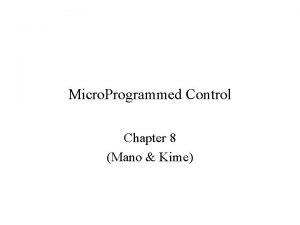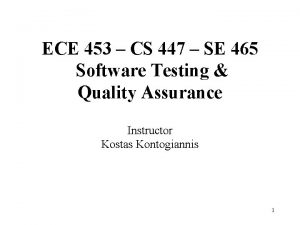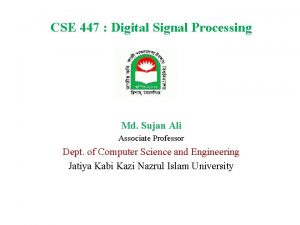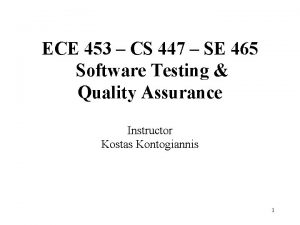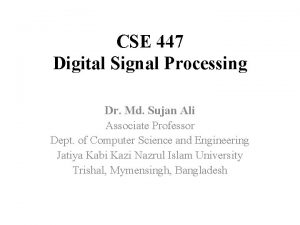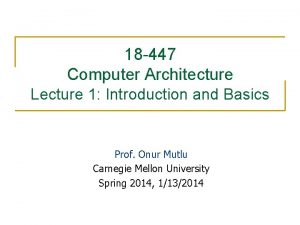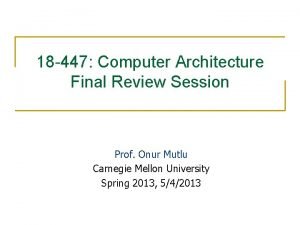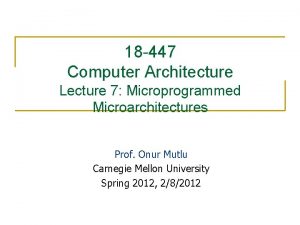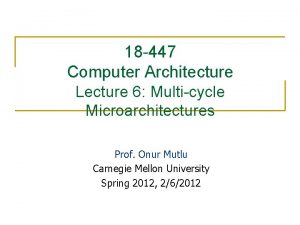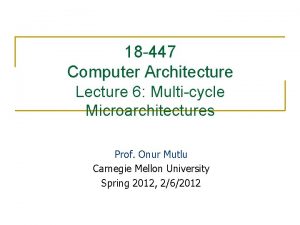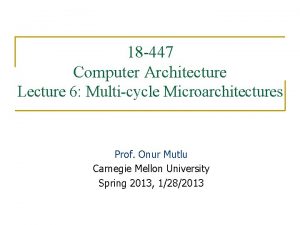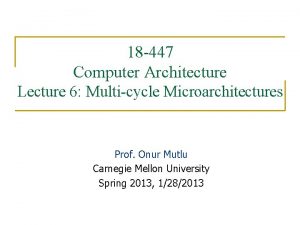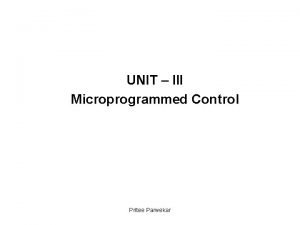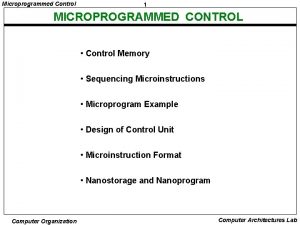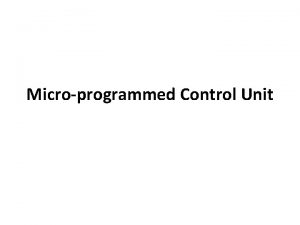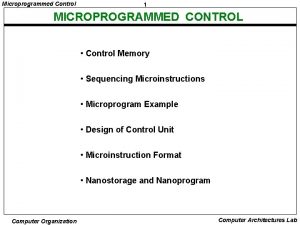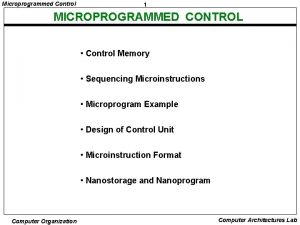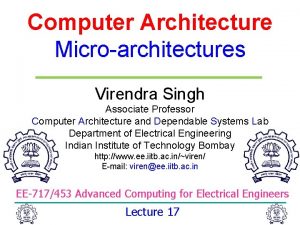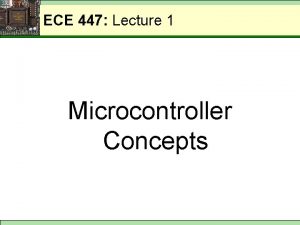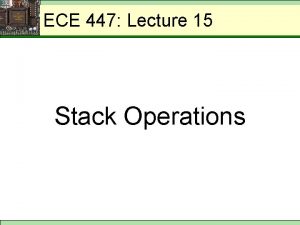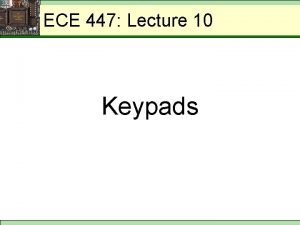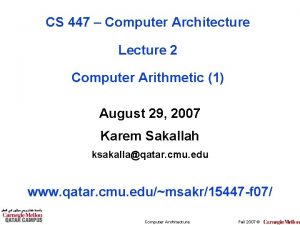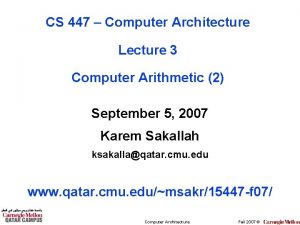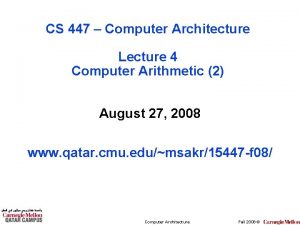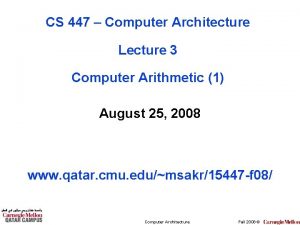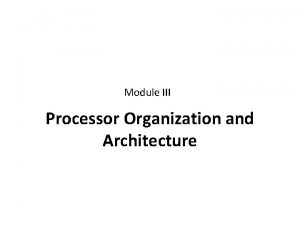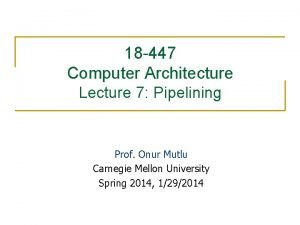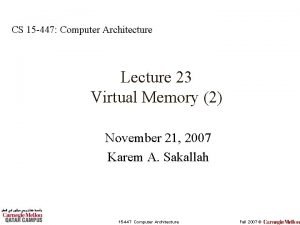18 447 Computer Architecture Lecture 7 Microprogrammed Microarchitectures











































- Slides: 43

18 -447 Computer Architecture Lecture 7: Microprogrammed Microarchitectures Prof. Onur Mutlu Carnegie Mellon University Spring 2013, 1/30/2013

Homework 2 n Homework 2 out q q q Due February 11 LC-3 b microcode ISA concepts, ISA vs. microarchitecture, microcoded machines 2

Reminder: Lab Assignment 1 n Due this Friday (Feb 1), at the end of Friday lab A functional C-level simulator for a subset of the MIPS ISA n Study the MIPS ISA Tutorial n Go to the Lab Sessions, especially if you need help n 3

Lookahead: Lab Assignment 2 n Lab Assignment 1. 5 q q n Verilog practice Not to be turned in Lab Assignment 2 q q Due Feb 15 Single-cycle MIPS implementation in Verilog All labs are individual assignments No collaboration; please respect the honor code 4

Lookahead: Extra Credit for Lab Assignment 2 n Complete your normal (single-cycle) implementation first, and n n n get it checked off in lab. Then, implement the MIPS core using a microcoded approach similar to what we will discuss in class. We are not specifying any particular details of the microcode format or the microarchitecture; you can be creative. For the extra credit, the microcoded implementation should execute the same programs that your ordinary implementation does, and you should demo it by the normal lab deadline. You will get partial credit for the extra credit Document what you have done and demonstrate well 5

Readings for Next Lecture n Pipelining q n P&H Chapter 4. 5 -4. 8 Pipelined LC-3 b Microarchitecture q http: //www. ece. cmu. edu/~ece 447/s 13/lib/exe/fetch. php? medi a=18447 -lc 3 b-pipelining. pdf 6

Today’s Agenda n Finish the Microprogrammed LC-3 b Design n Do some microprogramming n Start pipelining 7

Review: Last Lecture n n Finished single-cycle microarchitectures Microarchitecture design principles Basic performance evaluation (execution time equation) What does it mean to design for the common case (or bread and butter design)? q n n If memory takes 90% of execution time … How does the single cycle microarchitecture make “critical path design” difficult? Remember the performance equation that consists of three components… How can you improve each component in a multi-cycle microarchitecture? 8

Review: Microarchitecture Design Principles n Critical path design q n Find the maximum combinational logic delay and decrease it Bread and butter (common case) design q Spend time and resources on where it matters n q n i. e. , improve what the machine is really designed to do Common case vs. uncommon case Balanced design q q Balance instruction/data flow through hardware components Balance the hardware needed to accomplish the work 9

Review: Multi-Cycle Microarchitectures n Goal: Let each instruction take (close to) only as much time it really needs n Idea q q Determine clock cycle time independently of instruction processing time Each instruction takes as many clock cycles as it needs to take n n Multiple state transitions per instruction The states followed by each instruction is different 10

Quick Review: A Microprogrammed Multi-Cycle Microarchitecture 11

Review: The Instruction Processing Cycle q q q Fetch Decode Evaluate Address Fetch Operands Execute Store Result 12

Review: A Basic Multi-Cycle Microarchitecture n Instruction processing cycle divided into “states” n n A stage in the instruction processing cycle can take multiple states A multi-cycle microarchitecture sequences from state to process an instruction n The behavior of the machine in a state is completely determined by control signals in that state n The behavior of the entire processor is specified fully by a n In a state (clock cycle), control signals control finite state machine n n How the datapath should process the data How to generate the control signals for the next clock cycle 13

Review: Microprogrammed Control Terminology n Control signals associated with the current state q n Act of transitioning from one state to another q q n Determining the next state and the microinstruction for the next state Microsequencing Control stores control signals for every possible state q n Microinstruction Store for microinstructions for the entire FSM Microsequencer determines which set of control signals will be used in the next clock cycle (i. e. next state) 14

Review: A Simple LC-3 b Control and Datapath 15

Review: An LC-3 b State Machine n n n Patt and Patel, App C, Figure C. 2 Each state must be uniquely specified q Done by means of state variables 31 distinct states in this LC-3 b state machine q n Encoded with 6 state variables Examples q q q State 18, 19 correspond to the beginning of the instruction processing cycle Fetch phase: state 18, 19 state 33 state 35 Decode phase: state 32 16

Review: LC-3 b State Machine: Some Questions n How many cycles does the fastest instruction take? n How many cycles does the slowest instruction take? n Why does the BR take as long as it takes in the FSM? n What determines the clock cycle? n Is this a Mealy machine or a Moore machine? 17

LC-3 b Datapath n Patt and Patel, App C, Figure C. 3 n Single-bus datapath design q q q n At any point only one value can be “gated” on the bus (i. e. , can be driving the bus) Advantage: Low hardware cost: one bus Disadvantage: Reduced concurrency – if instruction needs the bus twice for two different things, these need to happen in different states Control signals (26 of them) determine what happens in the datapath in one clock cycle q Patt and Patel, App C, Table C. 1 18




LC-3 b Datapath: Some Questions n How does instruction fetch happen in this datapath according to the state machine? n What is the difference between gating and loading? n Is this the smallest hardware you can design? 22

LC-3 b Microprogrammed Control Structure n Patt and Patel, App C, Figure C. 4 n Three components: q n n n Microinstruction: control signals that control the datapath (26 of them) and determine the next state (9 of them) Each microinstruction is stored in a unique location in the control store (a special memory structure) Unique location: address of the state corresponding to the microinstruction q n Microinstruction, control store, microsequencer Remember each state corresponds to one microinstruction Microsequencer determines the address of the next microinstruction (i. e. , next state) 23




LC-3 b Microsequencer n n n Patt and Patel, App C, Figure C. 5 The purpose of the microsequencer is to determine the address of the next microinstruction (i. e. , next state) Next address depends on 9 control signals 27


The Microsequencer: Some Questions n When is the IRD signal asserted? n What happens if an illegal instruction is decoded? n What are condition (COND) bits for? n How is variable latency memory handled? n How do you do the state encoding? q q q Minimize number of state variables Start with the 16 -way branch Then determine constraint tables and states dependent on COND 29

An Exercise in Microprogramming 30

Handouts n n n 7 pages of Microprogrammed LC-3 b design http: //www. ece. cmu. edu/~ece 447/s 13/doku. php? id=manu als http: //www. ece. cmu. edu/~ece 447/s 13/lib/exe/fetch. php? m edia=lc 3 b-figures. pdf 31

A Simple LC-3 b Control and Datapath 32



State Machine for LDW State 18 (010010) State 33 (100001) State 35 (100011) State 32 (100000) State 6 (000110) State 25 (011001) State 27 (011011) Microsequencer







End of the Exercise in Microprogramming 42

Homework 2 n You will write the microcode for the entire LC-3 b as specified in Appendix C 43
 Block diagram of microprogram sequencer
Block diagram of microprogram sequencer Microprogrammed control unit block diagram
Microprogrammed control unit block diagram Control unit operation
Control unit operation Architecture lecture notes
Architecture lecture notes Computer architecture lecture
Computer architecture lecture No poder de cristo mestre
No poder de cristo mestre 3 fázisú mérőhely kialakítása
3 fázisú mérőhely kialakítása Cs 447
Cs 447 Digital signal processing
Digital signal processing 710 hangi onluğa yuvarlanır
710 hangi onluğa yuvarlanır 447 bc
447 bc Cs 447
Cs 447 Shannon is making identical balloon arrangements
Shannon is making identical balloon arrangements Roc
Roc 18-447
18-447 Fces
Fces 01:640:244 lecture notes - lecture 15: plat, idah, farad
01:640:244 lecture notes - lecture 15: plat, idah, farad 3 bus architecture
3 bus architecture Difference between computer architecture and organization
Difference between computer architecture and organization Basic computer organization and design
Basic computer organization and design Computer security 161 cryptocurrency lecture
Computer security 161 cryptocurrency lecture Computer-aided drug design lecture notes
Computer-aided drug design lecture notes Architecture business cycle in software architecture
Architecture business cycle in software architecture Call and return architecture
Call and return architecture Integral architecture example
Integral architecture example Modular architecture vs integrated architecture
Modular architecture vs integrated architecture Computer organization and architecture 10th solution
Computer organization and architecture 10th solution Intel pentium
Intel pentium Ripple carry adder virtual lab
Ripple carry adder virtual lab Introduction to computer organization and architecture
Introduction to computer organization and architecture Timing and control in computer architecture
Timing and control in computer architecture Computer architecture: concepts and evolution
Computer architecture: concepts and evolution I/o interface in computer architecture
I/o interface in computer architecture Fp adder
Fp adder Absolute addressing mode
Absolute addressing mode Static interconnection network in computer architecture
Static interconnection network in computer architecture Smt computer architecture
Smt computer architecture Mips div
Mips div Collision vector in pipelining
Collision vector in pipelining Instruction format in computer architecture
Instruction format in computer architecture Nano programming in computer architecture
Nano programming in computer architecture Memory system design in computer architecture
Memory system design in computer architecture Memory hierarchy
Memory hierarchy Linear pipeline processors
Linear pipeline processors

